Wetlands and woodwinds might seem like unrelated topics, but a closer look reveals an intriguing connection between them. Wetlands, with their rich and diverse ecosystems, have inspired various forms of art and music. Woodwind instruments, known for their unique sounds, often capture the essence of nature. This article explores how wetlands influence woodwind music, the role of nature in musical creation, and why preserving wetlands is vital for both environmental and artistic reasons.
Understanding Wetlands
Wetlands are areas where water covers the soil or is present at or near the surface of the soil for part of the year. They include marshes, swamps, bogs, and estuaries. Wetlands play a crucial role in maintaining ecological balance.
Ecological Significance: Wetlands are home to a variety of plants and animals. They help filter pollutants from water, control floods, and support biodiversity. They are also essential for groundwater recharge and provide habitat for wildlife.
Cultural Value: Beyond their ecological benefits, wetlands have cultural and aesthetic significance. Many cultures value wetlands for their beauty and spiritual importance. Artists and musicians often find inspiration in the tranquil and complex environments of wetlands.
The Woodwinds Family
Woodwind instruments produce sound by blowing air across a mouthpiece or through a reed. The family includes flutes, clarinets, oboes, and bassoons. Each has its own distinct sound and character.
Flutes: These instruments produce sound by blowing air across an opening. They are known for their bright and airy tones. Flutes often evoke a sense of lightness and airiness in music.
Clarinets: Clarinets use a single reed to produce sound. They are versatile instruments with a warm and rich tone. Clarinets can convey a wide range of emotions and are featured in various musical genres.
Oboes: Oboes use a double reed to create sound. They are known for their penetrating and expressive tone. Oboes are often used to represent the sounds of nature in compositions.
Bassoons: These instruments use a double reed and have a deep, resonant tone. Bassoons add depth and texture to music and are known for their unique timbre.
How Wetlands Influence Woodwind Music

Wetlands provide a rich auditory environment that can inspire woodwind music. The natural sounds found in wetlands, such as flowing water, rustling reeds, and bird calls, can be mimicked by woodwind instruments.
Natural Inspiration: Many composers draw inspiration from the sounds of wetlands. The gentle rustling of reeds or the call of birds can influence the melodies and rhythms of woodwind music. Composers use these natural sounds to evoke the essence of wetlands in their compositions.
Musical Compositions: Composers often create pieces that reflect the beauty and complexity of wetlands. Woodwind instruments are used to capture the ambiance of these environments. For example, a composition might use the flute to mimic the sound of wind through reeds or the oboe to evoke the calls of wetland birds.
Field Recordings: Field recordings of wetland environments can be used as a source of inspiration for woodwind music. These recordings provide a direct link to the natural sounds of wetlands and can be incorporated into compositions or used as a basis for creating new music.
Examples of Wetland-Inspired Music
Several musical works have been inspired by wetlands and natural environments. These pieces often use woodwind instruments to capture the essence of wetlands.
Claude Debussy’s “Prelude to the Afternoon of a Faun” is one example. This piece is associated with lush, natural imagery, including wetlands. The woodwind instruments in this composition help evoke the feeling of a serene, mystical landscape.
Field Recordings of Wetland Sounds are also used in various musical compositions. These recordings provide a rich auditory backdrop and can enhance the emotional and atmospheric qualities of the music.
The Importance of Preserving Wetlands
Preserving wetlands is essential for maintaining their ecological and artistic value. Wetlands provide crucial environmental services and inspire creativity in art and music.
Environmental Preservation: Protecting wetlands helps maintain biodiversity and ecological balance. Wetlands filter pollutants, control floods, and support a wide range of species. Conservation efforts are necessary to ensure that these ecosystems remain healthy and functional.
Artistic Inspiration: Wetlands offer a unique source of inspiration for artists and musicians. By preserving these environments, we ensure that future generations can continue to draw inspiration from their beauty and complexity.
Educational Programs: Educational programs that focus on the connection between wetlands and woodwinds can help raise awareness about the importance of wetland conservation. These programs may include workshops, performances, and activities that highlight the relationship between nature and music.
How Woodwind Music Can Support Wetland Conservation
Woodwind music can play a role in supporting wetland conservation through various initiatives. Musicians and composers can use their art to raise awareness and promote environmental stewardship.
Concerts and Performances: Musicians can dedicate performances to wetland conservation. These concerts can feature works inspired by wetlands and include educational components about the importance of preserving these ecosystems.
Collaborations with Conservation Organizations: Musicians can collaborate with conservation organizations to support wetland preservation efforts. By participating in fundraising events and awareness campaigns, they can contribute to the protection and restoration of wetland environments.
Educational Outreach: Educational programs that incorporate woodwind music can engage students and the community in environmental issues. These programs can help foster a deeper understanding of the connections between nature and the arts.
Conclusion
The connection between wetlands and woodwinds is a testament to the harmony between nature and art. Wetlands provide a rich source of inspiration for woodwind music, and the preservation of these ecosystems ensures that their beauty and ecological functions continue to enrich our lives and creativity.
By exploring the relationship between wetlands and woodwinds, we celebrate the profound impact that natural environments have on artistic expression. Protecting wetlands not only supports ecological health but also preserves the artistic and cultural inspiration they provide. Through music and conservation efforts, we can honor and protect these vital ecosystems for future generations.










































